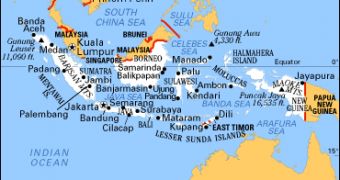Okeanos Explorer, the NOAA's ship that travels the globe to map all of the oceanic floor has discovered and mapped a huge underwater volcano called Kawio Barat. It is more that 3,048 meters tall and its name came from the Indonesian Kawio Islands, south of the Philippines.
The mission of the US NOAA - National Oceanic and Atmospheric Administration – is to map the entire sea floor, as almost 95 percent of the ocean remains undiscovered. In a month, it scanned 2,400 square miles of the Indonesian seafloor.
The Okeanos Explorer ship has a sonar and its own Remote Operating Vehicle (ROV), an underwater robot that allows filming the depths and broadcasting real-time images. It can go down as far as 6000 meters in depth, while being piloted by crew on the ship. The images it captures are broadcast live via Internet2, to the command centers on land, in the US. This ship is the only one to have its own permanent ROV and control room, because these robots are usually removed after each mission.
Microbiologist Jim Holden of the University of Massachusetts in Amherst, and also a team member said that “this is a huge undersea volcano, taller than all but three or four mountains in Indonesia, and rising more than 10,000 feet from the seafloor in water more than 18,000 feet (5,486 meters) deep. The more we understand these undersea features and the communities of life they support, the better we can manage and protect the ocean and its resources."
Discovering the ocean's floor with its living creatures and its relief will help scientists and administrations protect this unknown world. Humanity might be able to better understand what the climate change is doing to the planet and what are the effects that the global warming has on the underwater ecosystems.
This mapping expedition will continue mid-July, as the Baruna Jaya IV Indonesian research ship will explore the seafloor within the Kawio Islands. Both vessels will meet in Port of Bitung and will continue exploring the ocean near Sangihe and Talaud Islands, until the end of the expedition, August 14.

 14 DAY TRIAL //
14 DAY TRIAL //